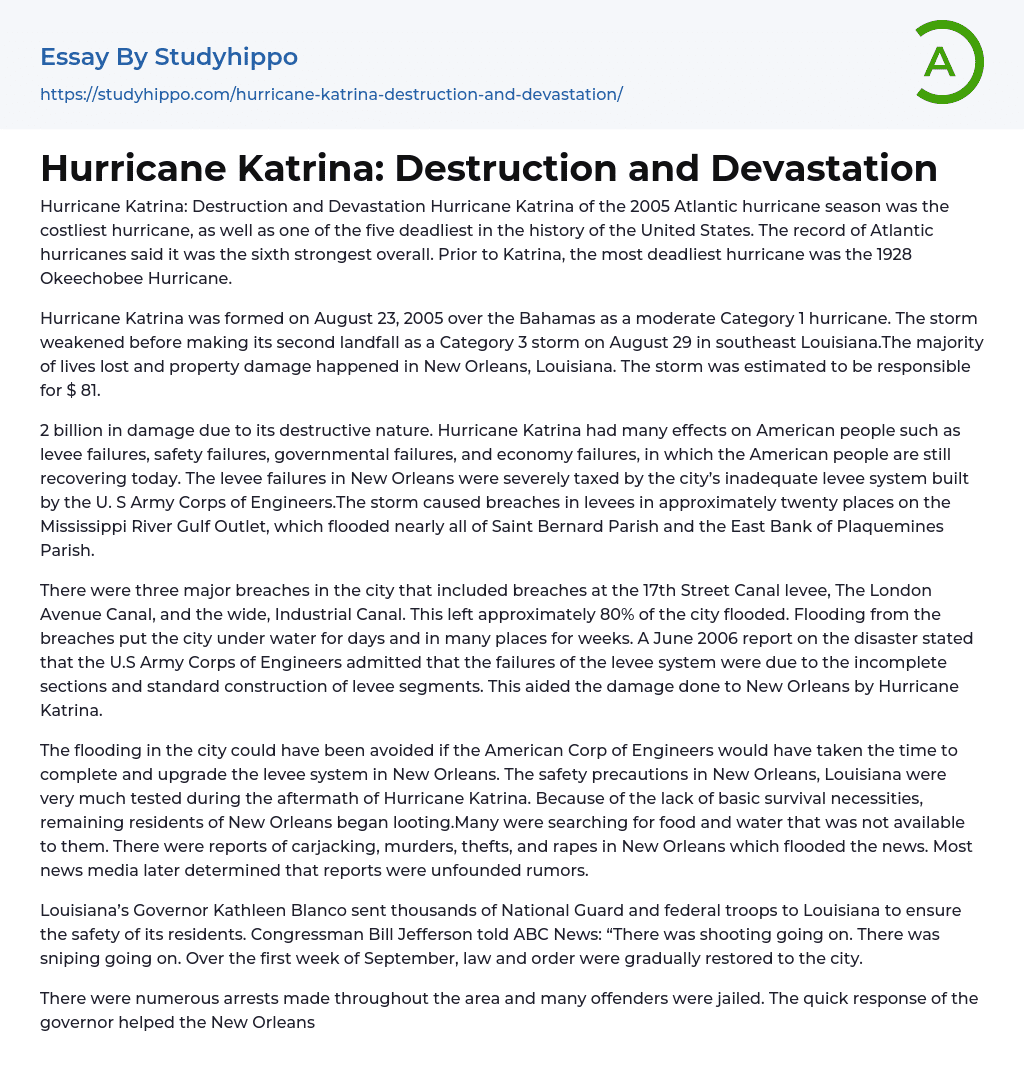

Hurricane Katrina: Destruction and Devastation Essay Example
The 2005 Atlantic hurricane season resulted in significant damage and casualties due to Hurricane Katrina. It is among the top five deadliest hurricanes ever recorded and holds the title of being the most expensive hurricane in U.S. history. The only hurricane to cause more destruction was the 1928 Okeechobee Hurricane. Despite ranking sixth in strength among all Atlantic hurricanes, its impact was unprecedented.
Hurricane Katrina began on August 23, 2005 in the Bahamas as a moderate Category 1 hurricane. Although it weakened, it hit southeast Louisiana as a stronger Category 3 hurricane on August 29. The most significant destruction and loss of life occurred in New Orleans, Louisiana. Overall, Hurricane Katrina resulted in an estimated cost of $81.
The destructive impact of Hurricane Katrina on the American people resulted in a staggering $2 billion in damage. Its effec
...ts were widespread, affecting levees, safety, government, and economy. Recovery efforts are still ongoing today as these consequences continue to be felt. The inadequacy of the levee system in New Orleans was especially evident during the storm. The construction of this system by the U.S Army Corps of Engineers had significant shortcomings that led to multiple breaches along the Mississippi River Gulf Outlet, causing flooding in nearly all of Saint Bernard Parish and the East Bank of Plaquemines Parish.
During Hurricane Katrina, three breaches had a significant impact on the levees of the 17th Street Canal, The London Avenue Canal, and the wide Industrial Canal. This led to flooding that affected approximately 80% of New Orleans for several days or even weeks in some areas. The failure of the levee system was attributed to incomplete sections and non-standard construction of leve
segments as revealed by a report published in June 2006. The U.S Army Corps of Engineers accepted responsibility and acknowledged these factors.
The American Corp of Engineers aimed to enhance and finalize the levee structure in New Orleans to prevent inundation. The effectiveness of these measures was challenged during Hurricane Katrina's impact on Louisiana. Due to scarcity, some citizens had no choice but to engage in looting for survival necessities like food and water. While rumors regarding car theft, murder, robbery, and rape surfaced during this period, most were ultimately proven false.
Governor Kathleen Blanco deployed National Guard and federal troops to safeguard Louisiana's citizens. Despite instances of gun violence and sniping within the city, Congressman Bill Jefferson confirmed in an ABC News interview that law enforcement was eventually reestablished by early September.
The governor took quick action that resulted in the arrest and imprisonment of numerous offenders, contributing significantly to the restoration of safety and faith among New Orleans residents. However, the government's management of Hurricane Katrina received criticism for its lack of leadership and mismanagement. One significant critique was the delayed response to flooding in New Orleans, leaving political leaders and frustrated residents without access to essential necessities like food, water, security, or sanitation facilities. Mayor Ray Nagin and Governor Kathleen Blanco both faced criticism for their failure to implement an evacuation plan for those who could not leave.
The delayed emergency evacuation order by Mayor Nagin was the biggest government failure during Hurricane Katrina, leading to homelessness, hunger, and hazardous living conditions for many New Orleans residents and resulting in the loss of hundreds of lives. A quicker response could have prevented countless deaths. The
economic effects of Hurricane Katrina were significant.
The region experienced the most expensive natural disaster in U.S. history during April 2006, resulting in $105 billion being required by the Bush Administration for repairs and reconstruction. This event disrupted the supply of oil and exports of commodities like grain, causing damage to the economy. Hurricane Katrina was responsible for closing nine refineries and damaging thirty oil platforms.
Louisiana and Mississippi suffered immense devastation in the aftermath of Hurricane Katrina. The natural disaster left countless locals without work, leading to reduced income and spending power that rendered local governments incapable of collecting taxes. Moreover, the cyclone disrupted oil production which resulted in power outages and impeded fuel distribution. Some well-known casinos such as Hard Rock Hotel and Casino and Beau Rivage located on the Mississippi Gulf Coast had to close down due to structural damage inflicted by Katrina. As a result of major oil refineries and businesses being affected, these states incurred substantial financial losses.
In the 2005 Atlantic hurricane season, Hurricane Katrina had a profound impact on the United States. Families experienced heightened stress levels due to economic problems, police inefficiencies, inadequate levees, and government shortcomings. The aftermath included severe flooding along with surging prices and crime rates as administration policies faltered.
The impact of these events led mayors, governors, and presidential staff to reassess how people react to and manage natural disasters throughout the United States.
- Abolitionism essays
- Adam Smith essays
- American History essays
- American Revolution essays
- Ancient Egypt essays
- Articles Of Confederation essays
- Atlantic Slave Trade essays
- Aztec essays
- Benjamin Franklin essays
- Civil Rights Act of 1964 essays
- Civil Rights Movement essays
- Civil war essays
- Cleopatra essays
- French And Indian War essays
- Gettysburg essays
- Great Depression essays
- Hurricane Katrina essays
- Industrial Revolution essays
- Jamestown essays
- Manifest Destiny essays
- Mccarthyism essays
- Patrick Henry essays
- Pearl Harbor essays
- Pocahontas essays
- Prohibition essays
- Pyramids essays
- Salem Witch Trials essays
- Slavery essays
- The New Deal essays
- Thirteen Colonies essays
- Westward Expansion essays
- John Locke essays
- 9/11 essays
- A Good Teacher essays
- A Healthy Diet essays
- A Modest Proposal essays
- A&P essays
- Academic Achievement essays
- Achievement essays
- Achieving goals essays
- Admission essays
- Advantages And Disadvantages Of Internet essays
- Alcoholic drinks essays
- Ammonia essays
- Analytical essays
- Ancient Olympic Games essays
- APA essays
- Arabian Peninsula essays
- Argument essays
- Argumentative essays



